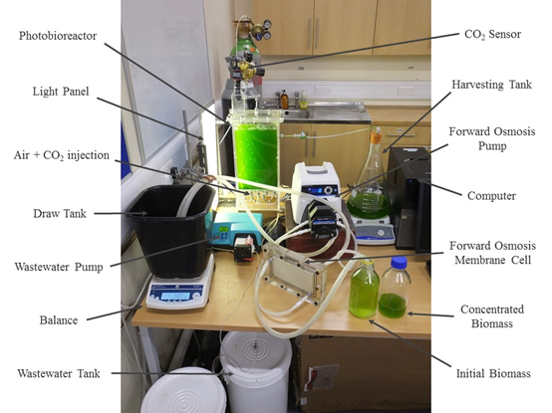
The energy required to treat wastewater is very high (0.5-0.6 kWh/m3). The increasing energy demand has, in a large part, been driven by increasingly stringent environmental regulations. Thus, there has been a push towards advanced treatment technologies, such as membrane bioreactors, that can guarantee very high quality effluent but at the price of increased energy usage. In the long-term, wastewater treatment will be far more environmentally and economically sustainable if we can, not only reduce the energy associated with pollution control, but also recover energy from the wastewater.
In addition to water sustainability, the continued use of fossil fuels is widely recognized as unsustainable and it is therefore vital we replace a significant amount of fossil fuel usage with renewable biofuels. Microalgae is currently the most promising feedstock for biofuels as they fix their carbon from carbon dioxide (CO2) and are capable of producing at least 10 times more oil than other oilseed crops. However, before algae biofuel production can be scaled up commercially numerous technical and economic challenges remain to be overcome. One key challenge is the high energy cost of algae harvesting which is important for the efficiency of subsequent oil extraction processes and accounts for up to 30-50% of the total cost of production. Water and energy are two fundamental building blocks. They are interconnected issues. Novel technologies that can achieve low energy and highly efficient wastewater treatment and microalgae harvesting will have a distinct advantage in a ready and expanding global market.
In this research, we develop, test and study a novel osmotic membrane photobioreactor (osMPBR) for advanced wastewater treatment and microalgae harvesting. Our conceptual design comprises a photobioreactor and a forward osmosis (FO) membrane module. Wastewater is fed into a photobioreactor where microalgae remove contaminants and then the water is further cleaned by FO membrane. In FO process, seawater is used to draw clean water out of the photobioreactor. The FO permeate water has high quality and can be discharged back to the sea with little environmental impact (or reclaimed) subsequently. Meanwhile, the microalgae can be harvested by FO at almost zero energy input.